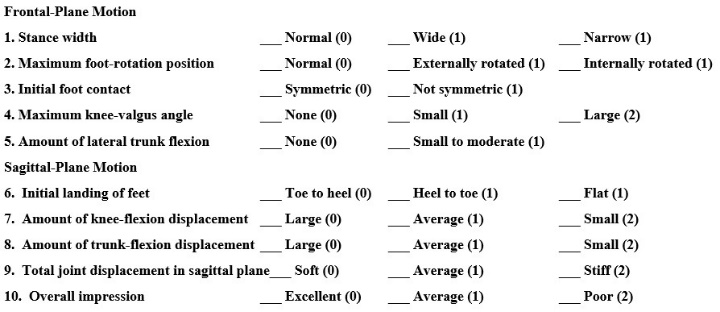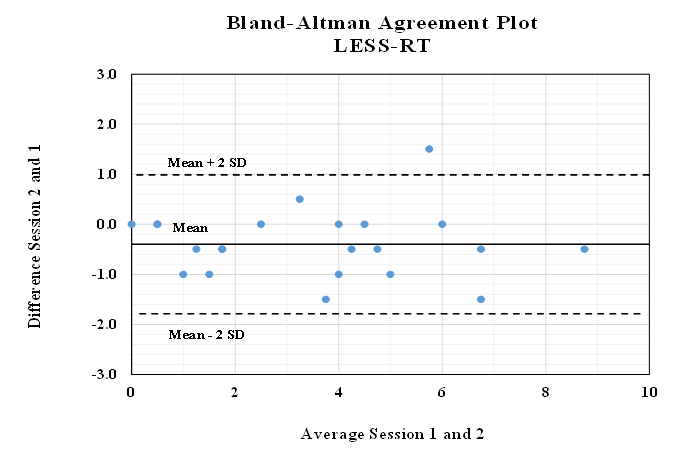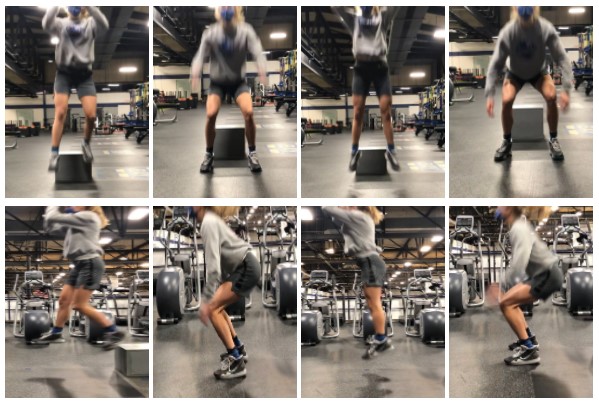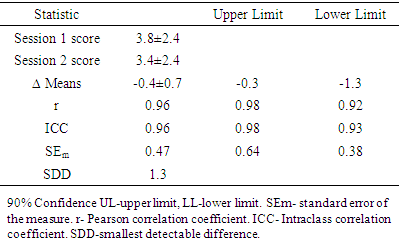-
Paper Information
- Paper Submission
-
Journal Information
- About This Journal
- Editorial Board
- Current Issue
- Archive
- Author Guidelines
- Contact Us
International Journal of Sports Science
p-ISSN: 2169-8759 e-ISSN: 2169-8791
2021; 11(1): 18-24
doi:10.5923/j.sports.20211101.03
Received: Apr. 26, 2021; Accepted: May 20, 2021; Published: May 28, 2021

Is the Landing Error Scoring System-Real Time a Reliable Tool for Assessing Jump-Landing Biomechanics?
Jon Schneider, Mark DeBeliso
Department of Kinesiology and Outdoor Recreation, Southern Utah University, Cedar City, UT, USA
Correspondence to: Jon Schneider, Department of Kinesiology and Outdoor Recreation, Southern Utah University, Cedar City, UT, USA.
| Email: |  |
Copyright © 2021 The Author(s). Published by Scientific & Academic Publishing.
This work is licensed under the Creative Commons Attribution International License (CC BY).
http://creativecommons.org/licenses/by/4.0/

An injury of the anterior cruciate ligament (ACL) is among the most difficult injuries for an athlete to sustain and recover from. Adolescent females are particularly vulnerable to non-contact ACL injuries. The Landing Error Scoring System- Real Time (LESS-RT) was developed as a fast and inexpensive method to assess an athlete’s risk of a non-contact ACL injury. However, the reliability of the LESS-RT has yet to be determined among adolescent females. Hence the purpose of this study was to determine the reliability of the LESS-RT among adolescent females. Twenty-two adolescent females completed two sessions of jump-landings tasks with their mechanics scored by the LESS-RT protocol. The LESS-RT scores were compared between sessions with: Δ Mean between session scores, interclass reliability coefficients (r), intraclass reliability coefficients (ICCs), standard error of measurement (SEm), smallest detectable difference, scatter and Bland-Altman plots. The results of the two LESS-RT sessions (mean±SD) were 3.8±2.4 and 3.4±2.4 respectively. The interclass reliability coefficients with 90% confidence limits was: r=0.96 (UL: 0.98, LL: 0.92). The ICC with 90% confidence limits was: ICC=0.96 (UL: 0.98, LL: 0.93). The SEm with 90% confidence limits was: SEm=0.47 (UL: 0.64, LL: 0.38). The Bland-Altman plots indicated agreement between LESS-RT session scores. Within the parameters of this study it appears that the LESS-RT is a reliable instrument for scoring landing mechanics which are associated with the risk of non-contact ACL injury.
Keywords: Anterior cruciate ligament, Injury prevention, Movement assessment
Cite this paper: Jon Schneider, Mark DeBeliso, Is the Landing Error Scoring System-Real Time a Reliable Tool for Assessing Jump-Landing Biomechanics?, International Journal of Sports Science, Vol. 11 No. 1, 2021, pp. 18-24. doi: 10.5923/j.sports.20211101.03.
Article Outline
1. Introduction
- Lower extremity injuries are often the most challenging injuries to an athlete in regards to rehabilitation, time to recovery, cost, and future injury risk association [1]. The anterior cruciate ligament (ACL) injury is one of the most common and devastating lower-extremity injuries [2]. A higher risk of non-contact ACL injuries has been linked to jump-landing biomechanic’s errors [3,4].Certain groups of individuals appear to be at an increased risk of lower-extremity injuries. Female athletes, often between the ages of 14-23, are at a greater risk of ACL injury, especially in sports such as soccer and basketball [1]. Nearly 70% of non-contact ACL injuries are a result of a significant force in the lower extremity that comes from cutting, jumping, or landing [2]. These particular movements are the basis for athletic performance in sports such as basketball and soccer. These biomechanical patterns include a great amount of hip, trunk, and knee mobility, and females commonly perform these movements with more errors [1]. There are also additional gender specific differences that appear to have an impact on non-contact ACL injuries. The patellar tendon tibial shaft angle may be a risk factor for non-contact ACL injuries, and females demonstrated a 13.2% higher anterior shear force applied to the tibia when compared to males. [5]. Females commonly exhibit landing patterns that show less trunk and hip flexion when compared to males. This reduced flexion results in decreased energy absorption ability which creates more force on the lower extremity joints and ligaments. Females often have greater hip adduction when performing common athletic movements like jumping and landing, cutting, and sprinting, compared to males [6]. Furthermore there is an observed difference in sex in which females often have an increase in knee valgus and internal hip rotation, putting the ACL at increased risk of injury [6].The ability to screen athletes on their jump-landing biomechanics, identify risk factors, and prescribe appropriate injury prevention programs is vital for athletes [3,4]. If a weakness is detected, then the appropriate plyometric or strength program can be implemented. Coaches, athletes, trainers, and others in the field of exercise science are always looking for the best training methods, especially when it comes to injury prevention [1]. Coaches and clinicians are continuously searching for budget and time efficient approaches for screening and training athletes [1,7,8]. Valid and objective assessment tools allow a clinician or coach to track where a current athlete is at compared to norm scores, as well as track their progress during training [7,8]. Likewise, valid and objective screening tests can provide practitioners with a sense of the potential for injury [7,8].Real-time tests like the Balance Error Scoring System and the Star Excursion evaluate an athletes balance. These two tests are valid and reliable but are not directly related to movement patterns associated with ACL injuries [8]. The Functional Movement Screen and Overhead Squat Tests screen movement patterns like a squat, lunge or step, but are mostly static movements and lack the speed and intensity of more dynamic jumping and landing movements [8]. The Tuck Jump Test is one of the few tests that evaluate a jump landing task, however the reliability and validity of the Tuck Jump test has yet to be established [9].One real time injury prevention test that is considered as valid and reliable is the Landing Error Scoring System (LESS) [7]. The LESS scores an athlete’s landing biomechanics compared to a set list of perfect landing techniques [7]. The LESS has demonstrated good to excellent intra-rater (ICC = 0.82 to 0.99), inter-rater (ICC = 0.83 to 0.92), and inter-session reliability (ICC = 0.81) [7].More recently, a modified, efficient, real time scoring system has been developed; the Landing Error Scoring System-Real Time (LESS-RT) [8]. To date there is currently only one published study measuring the reliability and validity of the LESS-RT. That particular study done by Padua et al. [8] assessed male and female athletes between the ages of 18-23 using the LESS-RT. However, the most vulnerable to non-contact ACL injuries are adolescent females [6,10-13]. As such, the purpose of this study was to determine the reliability of the LESS-RT among female high school athletes between the ages of 14-18.
2. Methods
2.1. Participants
- Healthy high school female student-athletes were recruited and later volunteered for participation in this study. Inclusion criteria was that participants had no current lower extremity injuries. Subjects and guardians provided written informed assent/consent after being briefed on the study procedures verbally and in writing. All participants completed the PAR-Q+ prior to participating in the study [14]. This study was approved by the Southern Utah University IRB Committee.
2.2. Procedures
- All participants performed two sessions of the LESS-RT. Each session required 4 jump trials of a standardized jump-landing task (8 jump trials total). The participants were required to jump forward from a 30 cm-high-box, which was set at a distance of 50% of their height away from the target landing area. They landed in the target touchdown area and immediately performed a maximum effort vertical jump (VJ) with minimal pause upon the landing (Figure 1). The participants were instructed to always have the same starting position on the box and to jump as high as they could on the rebounding VJ. Other than those instructions the participants were not given feedback between trials on technique. All participants were allowed to take 1-3 practice trials to feel confident in performing the task.
 | Figure 2. Operational Definitions of Individual Items on the Landing Error Scoring System Real-Time (LESS-RT) [8] |
 | Figure 3. Scoring sheet for the Landing Error Scoring System Real-Time (LESS-RT) [8] |
- During trials 1 and 2 the participants were scored from a frontal view. During trial 1, stance-width, maximum foot-rotation position, and initial foot-contact symmetry were scored. Trial 2 included scoring on maximum knee-valgus movement, and the amount of lateral trunk flexion. For trials 3 and 4, a sagittal view was used to score. During trial 3, the initial landing of the feet, and the amount of knee-flexion displacement were scored. For trial 4, the amount of trunk flexion displacement was scored. During trials 3 and 4 the total joint displacement in the sagittal plane were scored. Finally, an overall impression is scored. These jumps were scored using the scoring sheet listed in Figure 3. Operational definitions of each scoring category are listed in Figure 2. Trials were separated by about 15 seconds. Session one and two were separated by 30 seconds. The participants were then given a final score for each session by totaling all points from jump-trials 1-4 combined and then averaging the scores from the two raters ([rater 1 total score + rater 2 total score]/2). As such, the possible range of LESS-RT scores was 0-15. Each session took about 3 minutes from explanation to jump trials, totaling the entire testing period with each athlete at about 6 minutes. Both raters have ≥10 years of strength and conditioning coaching, physical education teaching and sport coaching experience.
2.3. Statistical Analysis
- The current investigation examined the test-retest reliability of the LESS-RT scoring as assessed over two sessions. There is considerable debate as to the most accurate statistical method for determining the reliability of an instrument [16-22]. As such, several statistical methods were employed to examine the test-retest reliability of the LESS-RT scores which included: interclass (Pearson’s r) and intraclass reliability coefficients (ICC), the mean difference between trials, and the standard error of measurement (SEm) including 90% upper and lower limits (UL, LL). A scatter diagram and a Bland-Altman plot were also provided in order to examine error uniformity [17]. A spreadsheet developed by Hopkins [17] and Microsoft Excel 2015 were used for all statistical calculations, data management, and graphing. The LESS-RT scores were peer reviewed for exactitude prior to analysis [23]. This statistical approach is consistent with prior reliability investigations [24-27]. The smallest detectable difference (SDD) is considered the minimum magnitude of change required in order to assure that a “true” change has occurred. The SDD was calculated using equation 1 [18,21].
 | (1) |
3. Results
- The participants (n=22) completed both sessions of a total of 8 jump trials from the LESS-RT without complication. Participant demographics are provided in table 1. Table 2 provides the LESS-RT Scores and session 1 and 2 statistics.
|
|
 | Figure 4. Scatter Plot LESS-RT Session 1 and 2 Scores |
 | Figure 5. Bland-Altman plot comparing the Session average scores versus the difference scores |
4. Discussion
- The purpose of this study was to measure the test re-test reliability of the LESS-RT among female athletes between the ages of 14 and 18 years. It was hypothesized that the LESS-RT would be a reliable tool for assessing jump-landing biomechanics in female high school athletes. The analysis of data collected provides evidence in support of the research hypothesis.In the current study the intra-class reliability coefficient between sessions was ICC=0.96 (UL: 0.98, LL: 0.93), considered as excellent [16]. The interclass reliability coefficient was r=0.96 (UL: 0.98 LL: 0.92) considered as high [22]. The SEm=0.47 or less than one score point of a total range of LESS RT scores of 0-15. The SDD=1.3 indicating that one would only need to detect a slightly greater that a 1-point change in LESS-RT scores to detect a ‘true” change in landing mechanics [18,21]. The mean difference in LESS-RT scores between sessions Δ mean = -0.4±0.7 or less than a half of a LESS RT point. These findings support notion that the LESS-RT is a reliable tool for scoring landing mechanics of female high school athletes who may be at a higher risk of non-contact ACL injuries.Prior research regarding the LESS (non-real time) [7] demonstrated good to excellent intra-rater (ICC=0.91) and inter-rater (ICC=0.84) reliability. Padua’s [8] research regarding the LESS-RT indicated good interrater reliability (ICC range 0.72-0.81). The current study demonstrated superior LESS-RT reliability relative to the aforementioned study by Padua [8]. The current study used two raters to score the LESS-RT for each session. The average of the two rater’ scores were then compared between each session in order to assess test-retest reliability. The Padua study [8] examined interrater reliability of three raters and did not average scores as in the current study which likely explains the lower reliability then in the current study.With that said, we decided to include some additional a posteriori statistical analysis. Rater 1 average session 1 and 2 LESS-RT scores were: 3.7±2.3, 3.8±2.4 respectively. Rater 2 average session 1 and 2 LESS-RT scores were: 3.8±2.4, 3.3±2.7 respectively. The interclass reliability coefficient between the raters scores during session 1 and 2 were: r=0.89 and r=0.91 respectively (i.e. inter-rater reliability). The interclass reliability coefficient for each rater between sessions 1 and 2 were: r=0.94 and r=0.92 respectively (i.e. intra-rater reliability). Given the aforementioned average session scores that were separated by less than a half a point in landing error, and the high interclass and intra-class reliability coefficients, it would appear that only one rater is necessary to reliably score the LESS-RT among this population.The LESS-RT scores recorded in the Padua study [8] across two sessions amongst three scores averaged 5.6. The average LESS-RT scores for the two sessions in the current study were 3.8±2.4 and 3.4±2.4 respectively. At this juncture it is not known why adolescent female athletes would exhibit less landing errors than the participants in the Padua et al. [8] study whom were Military Academy freshman cadets. Padua et al. [8] however did make mention that the freshman cadets were not exclusively athletes. Presumably non-athlete participants could have contributed to a higher number of landing errors. Padua et al. [8] did not mention the attire of the freshman cadets during the jump trials. If baggy clothing was worn by the cadets, it is possible that the perspective of the raters was obscured leading to erroneous LESS-RT scores. Conversely, it is also possible that the size of an adult leads to a more accurate scoring of a landing because it is easier to discern angular displacements due to the larger limbs.There were some assumptions associated with the study. The first was that the participants gave maximum effort during the test, specifically during the maximum vertical jump portion. The second was that identical instruction was given by the administrator, and followed by the participant. Finally, during the jump trials, the participant was comfortable with performing the task properly. There are several limitations within this study. One includes the injury history of the participants. We used the PAR-Q+ [14] to screen athletes for previous lower extremity injuries and any athlete that had a serious lower extremity injury in the past 12 months was excluded. Prior injury history beyond 12 months was not considered in the current study. A second was the timing of each participant being tested. Many of the participants were currently in a conditioning program that helps strengthen certain lower body muscle groups, and they could have had either strengthened or fatigued muscles during the study sessions. A third limitation was a small sample (n=22) which included only female athletes that currently attend Whitefish Bay High School (Wisconsin USA). A final limitation includes a lack of experience of the scorers. Both scoring parties had zero previous experience in rating the LESS-RT in a clinical setting, however each practiced scoring in exhibition trials on random students within the same age group. Interestingly, in spite of the aforementioned limitations, the demonstrated test-retest reliability was exceptionally strong.Research of ACL injury prevention is an important topic in sports medicine. The ability to screen and diagnose weaknesses in lower extremities, and prescribe an appropriate injury prevention training program for athletes is vital. The first step in this process is the assessment of athletes doing sport specific movements and identifying potential risk factors. The LESS-RT scores frontal, sagittal and transverse plane angular displacements. The sagittal plane assesses heel to toe foot contact, knee, hip, and trunk flexion which corresponds to the LESS-RT items: 6, 7, 8, and 9. Frontal plane assesses stance width, foot-contact symmetry, knee-valgus, and lateral trunk flexion which corresponds to LESS-RT items: 1, 3, 4, and 5. The transverse plane assesses foot-rotation position and corresponds to LESS-RT item 2. All of the LESS-RT items are scored such that higher scores are reflective of landing errors that have been linked to non-contact ACL injuries [2-5,28-30].Future research should focus on linking the range of LESS-RT scores to a scale that indicates when an intervention should be undertaken to improve landing mechanics. A second research endeavor might be a replication of the current study that includes cameras for the purpose of videoing the jump landings. Such a study would allow for the comparison of the real-time scoring with the video, hence providing a direct statement regarding concurrent validity. Finally, given the increased risk of non-contact ACL injuries among adolescent females [1], a modified LESS-RT that is specific to gender and age maybe warranted.
5. Conclusions
- Research of ACL injury prevention is an important topic in sports medicine. The ability to screen and diagnose weaknesses in lower extremities, and prescribe an appropriate injury prevention training program for athletes is vital. The need for early detection of ACL injury risk factors for coaches, doctors, and trainers is important so they can intervene appropriately. The LESS-RT provides the ability to screen athletes quickly, using a reliable testing protocol, without the need for expensive equipment. Within the parameters of this study, the LESS-RT should be considered a reliable protocol for the purpose of scoring landing mechanics among female high school athletes.
ACKNOWLEDGEMENTS
- The College of Health Sciences, Southern Utah University, Cedar City, and Whitefish Bay High School, Whitefish Bay, WI.
 Abstract
Abstract Reference
Reference Full-Text PDF
Full-Text PDF Full-text HTML
Full-text HTML

